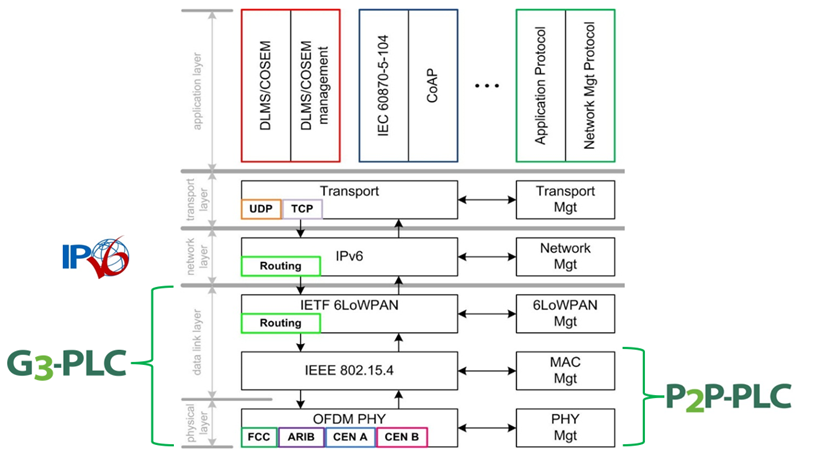P2P-PLC Certification
The G3-Alliance was formed in order to standardise and promote powerline and hybrid RF technology globally. Since its introduction, G3 technology has proven to be a very successful communication technology which offers highly reliable, long-range communication over the existing powerlines.
One of the key strengths is the OFDM-based PHY which not only makes efficient use of the spectrum, but also offers a selection of different modulations for higher rate communication or a “robust” mode to improve communication under noisy channel conditions, and channel estimation to select the optimal modulation scheme between neighbouring nodes. This is combined with the well-known IEEE 802.15.4-based MAC layer which is well suited to low data rates, and also offers AES-128 cryptographic engine for optimum data security and Adaptive tone mapping for optimal bandwidth utilization.
The successful combination of the G3-Alliance certification program and the technology itself has opened up the use of G3 technology to many other application areas, including:
- Smart Lighting and Smart Buildings
- Environmental monitoring
- Heating, ventilation and air conditioning systems (HVAC)
- Solar Panel Monitoring systems
- Fire and safety
- Robotic control
- Submersible pumps
- Multifunction printers
For some of these applications, where the topology is very simple or where limited numbers of devices are present in the network, a lightweight profile with a minimal memory footprint designed for point-to-point (i.e. not-routed) communications can be an advantage.
Therefore, the G3-Alliance introduced P2P-PLC (Point-to-Point PLC) certification to support G3 technology usage in these specific applications. The P2P-PLC certification covers all the existing certification profiles (CENELEC A / CENELEC B / FCC / ARIB) but limits the protocol stack to the PHY and MAC layers only. The objective of P2P-PLC certification is to allow multi-sourcing of platforms by product manufacturers and is therefore only open to platforms.
Using the IEEE 802.15.4-based MAC layer selections as described in the G3-ALLIANCE specifications (published by ITU: https://www.itu.int/rec/T-REC-G.9903) offers the following characteristics:
| P2P-PLC Key Characteristics | |
| PLC frequency bandplans |
•CENELEC-A 35.9 – 90.6 kHz •CENELEC-B 98.4 – 121.9 kHz •ARIB 154.7 – 403.1 kHz •FCC 154.7 – 487.5 kHz |
| Network type | Point-to-point communication |
| Transmission distance | Up to 1,7 km point-to-point communication, depending on network characteristics and the electrical grid topology, can be achieved in actual field conditions. |
| Data rate |
PHY data rate up to •CENELEC-A 44 kbps •CENELEC-B 22 kbps •ARIB 147 kbps •FCC 280 kbps |
| Point-to-Point RTT |
P2P Round trip time •CENELEC-A 72 msec •CENELEC-B 102 msec •ARIB 28 msec •FCC 24 msec |
| Supported modulations |
Differential modulations: ROBO, DBPSK, DQPSK, and D8PSK Coherent modulations: ROBO,BPSK, QPSK, 8-PSK and 16-QAM |
| Number of supported devices | P2P profile supports 16-bit addressing for both source and destination |
| Security | AES-128 (Advanced Encryption Standard with 128 bit key) encryption |
| Analog front end | Some P2P applications can benefit from a reduced BOM (amplifiers, transformers, etc.) |

P2P-PLC Certification Process
The P2P-PLC certification program is only open to platforms and was introduced to ensure that product manufacturers involved in the mentioned market areas can benefit from certified platforms, and thus enabling multi-sourcing. The P2P certification covers only the OFDM PHY and the IEE 802.15.4 MAC layer.
Any platform that has undergone full G3-Alliance certification can achieve P2P-PLC certification, provided the following conditions are met:
- Full access to the MAC layer is available for the end system.
- The G3-ALLIANCE ADP layer and G3-ALLIANCE PHY/MAC layers are clearly separated.
- Full G3-ALLIANCE testing of the stack must be performed, the G3 ADP layer may reside outside the P2P-PLC certified platform but must be present for certification.
The P2P-PLC certification uses the same test procedure as the G3-Alliance certification, a separate P2P-PLC test certificate is issued. The test procedures can be found here.
| Manufacturer | Model | PLC bandplan | Optional features | Date | See certificate |
|---|---|---|---|---|---|
| Renesas Electronics Corporation | R9A06G061GNP | ARIB | Coherent mode | 26/07/2023 | https://docs.google.com/viewer?url=https%3A%2F%2Fdegen-design.nl%2F%2Fdownload%2F126%2Fp2p-certificates%2F3836%2Fp2p-2307-578-1-b6-p2p-plc-certificate-arib-renesas-electronics-corporation-r9a06g061gnp-for-publication.pdf |
| Renesas Electronics Corporation | R9A06G061GNP | FCC | Coherent mode | 27/04/2023 | https://docs.google.com/viewer?url=https%3A%2F%2Fdegen-design.nl%2F%2Fdownload%2F126%2Fp2p-certificates%2F3639%2Fp2p-2304-571-1-c6-p2p-plc-certificate-fcc-renesas-electronics-corporation-r9a06g061gnp-for-publication.pdf |
